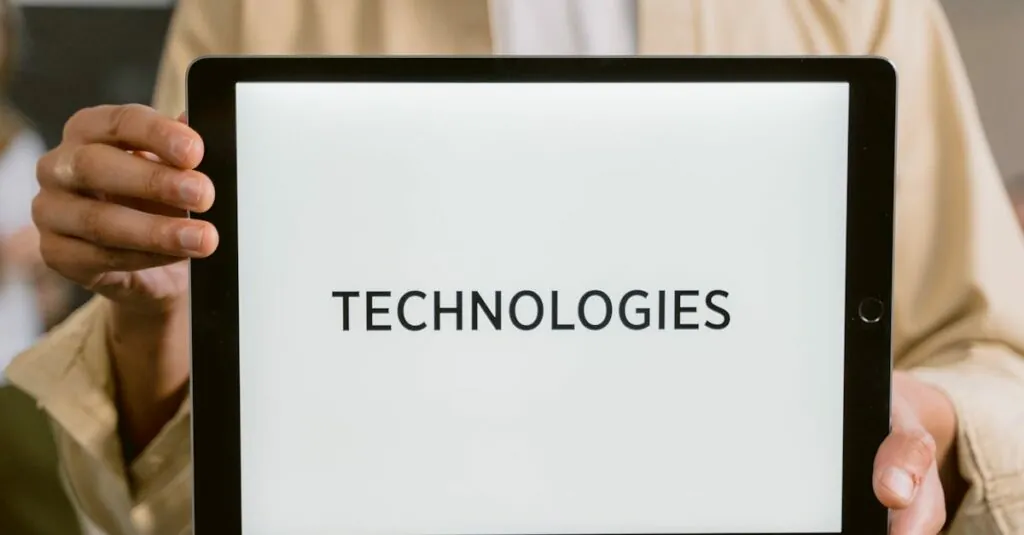As we gear up for 2025, the tech landscape is buzzing with excitement over emerging software technologies that promise to redefine how we work and play. Imagine a world where AI not only predicts your coffee order but also helps you avoid that awkward small talk at the office. Sounds like a dream, right? Well, buckle up because these innovations are closer than you think.
Table of Contents
ToggleOverview of Emerging Software Technologies 2025
Emerging software technologies in 2025 focus on several key advancements that transform industries. Artificial intelligence continues to dominate development, enabling applications across diverse fields. Machine learning algorithms enhance data analysis, automating insights for businesses.
Robotic process automation streamlines operations, reducing the need for manual intervention. This leads to increased efficiency and cost savings for organizations. Natural language processing improves communication systems, making technology more accessible and user-friendly.
Blockchain technology expands beyond cryptocurrencies, offering enhanced security and transparency for transactions. It finds applications in supply chain management, enabling traceability and authenticity verification. Edge computing becomes crucial as it allows data processing closer to the source, minimizing latency and bandwidth usage.
Augmented reality and virtual reality reshape user engagement, creating immersive experiences for consumers. These technologies find applications in training, education, and entertainment, enhancing learning and retention.
Developers emphasize the importance of cybersecurity as concerns increase with digital transformation. Solutions focus on advanced threat detection and response mechanisms to safeguard sensitive data. The rise of quantum computing introduces unprecedented processing power, promising breakthroughs in complex problem-solving.
Low-code and no-code platforms empower non-technical users to create applications, accelerating digital transformation initiatives. Collaboration tools advance further, improving remote teamwork and communication. These innovations collectively represent the forefront of technology, as organizations adapt to dynamic environments.
Key Trends Shaping the Future
Emerging software technologies are set to redefine industries, leading to greater efficiency and innovative solutions. Key trends provide insights into this future.
Artificial Intelligence Advancements
Artificial intelligence technologies continue to progress rapidly. Businesses leverage AI for predictive analytics, transforming customer interaction strategies. Enhanced algorithms enable improved personalization, tailoring user experiences effectively. Innovations in machine learning refine data processing methods, thus increasing performance across platforms. Natural language processing advancements streamline communication, breaking down barriers in user engagement. Improved AI-driven tools aid decision-making, making them indispensable in various sectors.
Cloud Computing Innovations
Innovations in cloud computing facilitate seamless access to resources. Organizations migrate to multi-cloud environments, enhancing flexibility and reducing dependency on a single provider. Enhanced security protocols ensure data protection in the cloud, addressing growing concerns. Cloud-native applications emerge, designed to maximize performance and scalability. Continuous integration and continuous deployment practices increase development efficiency, allowing teams to deliver updates rapidly. Serverless computing models simplify infrastructure management, enabling developers to focus on applications.
Edge Computing Developments
Edge computing technologies gain momentum by minimizing latency issues. Data processing occurs closer to the source, resulting in faster responses for critical applications. This shift supports real-time data analytics, essential for IoT devices. Enhanced security measures implemented at the edge reduce risks associated with centralized data processing. Companies utilize edge computing to optimize bandwidth usage, lowering costs associated with network traffic. As industries adopt this approach, efficiencies in operations and user experiences improve significantly.
Impact on Various Industries
Emerging software technologies are significantly shaping industries as we approach 2025. Key areas experiencing transformation include healthcare, finance, and education.
Healthcare
Artificial intelligence enhances diagnostic accuracy through predictive analytics. Patient data processing occurs in real-time, enabling timely interventions. Telemedicine expands access to care by connecting patients with providers remotely. Robotics assist in surgery, improving precision and recovery times. Blockchain secures patient records, ensuring data integrity and privacy. The integration of wearables offers continuous health monitoring, promoting proactive health management.
Finance
In finance, AI streamlines risk assessment and fraud detection, optimizing operational efficiency. Blockchain technology increases transparency in transactions and reduces costs through smart contracts. Automation in trading enhances speed while minimizing human error. Machine learning algorithms adapt to market trends, allowing for informed investment decisions. Regtech solutions improve compliance by monitoring regulations in real-time. Advanced analytics empower personalized financial services, enhancing customer engagement and retention.
Education
Education incorporates augmented reality to create immersive learning experiences. Virtual classrooms enhance accessibility for students globally. AI-driven platforms facilitate personalized learning paths, catering to individual student needs. Data analytics provides insights into student performance, guiding educators in curriculum adjustments. Collaboration tools enable seamless communication between students and instructors. Gamification in education increases engagement and motivation, fostering a deeper understanding of complex subjects.
Challenges and Considerations
Emerging software technologies face various challenges as organizations integrate innovative solutions. Security risks and implementation hurdles significantly impact the successful adoption of these advancements.
Security Risks
Cyber threats continue to evolve alongside technology. Data breaches can lead to the loss of sensitive information, causing reputational damage for businesses. Ransomware attacks require organizations to prioritize cybersecurity measures. Regulatory compliance becomes crucial as industries handle increasing amounts of personal and financial data. Organizations must ensure their systems are robust enough to withstand potential threats. Continuous updates and employee training play key roles in mitigating these risks. Security protocols should be regularly evaluated to adapt to new challenges.
Implementation Hurdles
Integrating new technologies often presents significant challenges. Staff may lack the necessary skills to effectively utilize these innovations. Financial constraints can limit investments in training and infrastructure needed to support these technologies. Resistance to change within an organization can slow down the adaptation process. Conducting thorough assessments of existing systems helps identify necessary upgrades and ensures compatibility. Clear communication regarding the benefits of new technologies fosters a more positive reception among employees. Adopting a phased implementation strategy often eases the transition to emerging solutions.
Emerging software technologies are set to revolutionize industries by 2025. The integration of AI, machine learning, and blockchain will redefine efficiency and security across various sectors. As organizations navigate the challenges of adopting these innovations, the focus on cybersecurity and employee training will be crucial.
The future promises enhanced user experiences through personalized solutions and real-time data analytics. With the rise of low-code and no-code platforms, non-technical users will gain unprecedented access to technology. Embracing these advancements will not only streamline operations but also foster a culture of innovation and adaptability. The journey ahead is filled with opportunities for those ready to embrace change.










